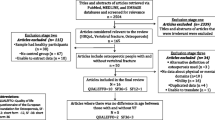Abstract
Summary
Not much is known about cross-geographic region differences in quality of life (QoL) in women with and without prevalent vertebral fractures (VFX). QoL differed between continents, countries, and ethnicities. The observed differences in QoL mostly appeared larger than the difference in QoL between women with or without mild to moderate VFX.
Introduction
Quality of life (QoL) is an increasingly important outcome measure in randomized controlled trials and cost-utility studies. However, not much is known about cross-geographic region differences in QoL. The objective of this study was to describe the cross-geographic region differences in QoL in women with and without mild to moderate prevalent vertebral fractures (VFX).
Methods
The study was performed using baseline data of the bazedoxifene study. The study was carried out in 25 countries in six continents (n = 7117). QoL was assessed using the index and Visual Analogue Scale (VAS) scores of the EQ-5D, Qualeffo-41, and Women's Health Questionnaire (WHQ). VFX were assessed using semi-quantitative and quantitative morphometric methods.
Results
In general, all four instruments followed more or less the same pattern. In most analyses, the reported QoL was lowest in Asia and Europe and highest in North America and Oceania. To examine the influence of ethnicity, North and South America were stratified on race. In both continents, a lower QoL was observed in Hispanic people.
Conclusions
QoL differed between continents, countries, and ethnicities. The observed differences in QoL appeared larger between most continents and countries than the difference in QoL between women with or without mild to moderate VFX.


Similar content being viewed by others
References
Hasserius R, Redlund-Johnell I, Mellstrom D et al (2001) Vertebral deformation in urban Swedish men and women - Prevalence based on 797 subjects. Acta Orthop Scand 72:273–278
Jones G, White C, Nguyen T et al (1996) Prevalent vertebral deformities: Relationship to bone mineral density and spinal osteophytosis in elderly men and women. Osteoporos Int 6:233–239
Lau EMC, Woo J, Chan H et al (1998) The health consequences of vertebral deformity in elderly Chinese men and women. Calcif Tissue Int 63:1–4
Melton LJIII, Lane AW, Cooper C et al (1993) Prevalence and incidence of vertebral deformities. Osteoporos Int 3:113–119
Pluijm SM, Tromp AM, Smit JH et al (2000) Consequences of vertebral deformities in older men and women. J Bone Miner Res 15:1564–1572
Silverman SL (1992) The clinical consequences of vertebral compression fracture. Bone 13(Suppl 2):S27–S31
Hall SE, Criddle RA, Comito TL et al (1999) A case-control study of quality of life and functional impairment in women with long-standing vertebral osteoporotic fracture. Osteoporos Int 9:508–515
Ross PD (1997) Clinical consequences of vertebral fractures. Am J Med 103:30S–42S
Ross PD, Davis JW, Epstein RS et al (1994) Pain and disability associated with new vertebral fractures and other spinal conditions. J Clin Epidemiol 47:231–239
Adachi JD, Loannidis G, Berger C et al (2001) The influence of osteoporotic fractures on health-related quality of life in community-dwelling men and women across Canada. Osteoporos Int 12:903–908
Cockerill W, Lunt M, Silman AJ et al (2004) Health-related quality of life and radiographic vertebral fracture. Osteoporos Int 15:113–119
Lips P, Cooper C, Agnusdei D et al (1999) Quality of life in patients with vertebral fractures. Validation of the Quality of Life Questionnaire of the European Foundation for Osteoporosis (QUALEFFO). Osteoporos Int 10:150–160
Oleksik A, Lips P, Dawson A et al (2000) Health-related quality of life in postmenopausal women with low BMD with or without prevalent vertebral fractures. J Bone Miner Res 15:1384–1392
Silverman SL, Minshall ME, Shen W et al (2001) The relationship of health-related quality of life to prevalent and incident vertebral fractures in postmenopausal women with osteoporosis: results from the Multiple Outcomes of Raloxifene Evaluation Study. Arthritis Rheum 44:2611–2619
Tosteson AN, Gabriel SE, Grove MR et al (2001) Impact of hip and vertebral fractures on quality-adjusted life years. Osteoporos Int 12:1042–1049
Brooks R, Rabin R, de Charro F (eds) (2003) The measurement and valuation of health status using EQ-5D: A European perspective. Kluwer, Boston
Dolan P (1997) Modeling valuations for EuroQol health states. Med Care 35:1095–1108
Lips P, Cooper C, Agnusdei D et al (1997) Quality of life as outcome in the treatment of osteoporosis: the development of a questionnaire for quality of life by the European Foundation for Osteoporosis. Osteoporos Int 7:36–38
Hunter MS (2003) The Women's Health Questionnaire (WHQ): Frequently Asked Questions (FAQ). Health Qual Life Outcomes 1:41
Hunter M (1992) The Womens Health Questionnaire—a measure of mid-aged womens perceptions of their emotional and physical health. Psychology & Health 7:45–54
Avis NE, Ory M, Matthews KA et al (2003) Health-related quality of life in a multiethnic sample of middle-aged women—Study of Women's Health Across the Nation (SWAN). Medical Care 41:1262–1276
Gupta P, Sturdee DW, Hunter MS (2006) Mid-age health in women from the Indian subcontinent (MAHWIS): general health and the experience of menopause in women. Climacteric 9:13–22
Alonso J, Ferrer M, Gandek B et al (2004) Health-related quality of life associated with chronic conditions in eight countries: results from the International Quality of Life Assessment (IQOLA) Project. Qual Life Res 13:283–298
Author information
Authors and Affiliations
Corresponding author
Additional information
Funding
The study was funded by Wyeth Research, Collegeville, Pennsylvania. The VU University Medical Center was one of the participating centers. Natasja van Schoor was funded by an unconditional grant from Wyeth; Joel Bobula is an employee of Wyeth and has stock ownership in Wyeth; Holly Yu is an employee of Wyeth.
Rights and permissions
About this article
Cite this article
van Schoor, N.M., Yu, H., Bobula, J. et al. Cross-geographic region differences in quality of life in women with and without vertebral fracture. Osteoporos Int 20, 1759–1766 (2009). https://doi.org/10.1007/s00198-009-0853-x
Received:
Accepted:
Published:
Issue Date:
DOI: https://doi.org/10.1007/s00198-009-0853-x




